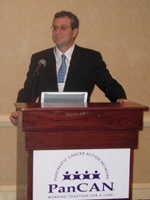While any diagnosis of cancer is frightening, pancreatic cancer can be particularly devastating. While it is not a commonly occurring cancer, it is the fourth-leading cause of cancer death in the United States. By far the largest number of pancreatic cancer diagnoses are made for advanced-stage pancreatic cancers—those that have spread beyond the original tumor to other organs or the lymph nodes—while less than 10 percent of pancreatic cancers are caught before spreading beyond the pancreas. These staggering numbers reflect the difficulty of making an early cancer diagnosis in the pancreas.
During a June 17th symposium in New York City by the Pancreatic Cancer Action Network (PanCAN), gastroenterologist Mark Pochapin and surgeon Michael Lieberman from the Jay Monahan Center for Gastrointestinal Health at Weill Cornell discussed emerging diagnostic and surgical strategies for patients with pancreatic cancer and their caregivers. The Jay Monahan Center, along with the Lustgarten Foundation, R.C. Hayes Memorial Foundation for Pancreatic Cancer Care, and CancerCare partnered with PanCAN to present the one-day symposium for individuals diagnosed with pancreatic cancer and their families, the first by the organization in New York City. "At the Monahan Center, we have been privileged to partner with PanCAN in providing the essential support and resources needed by our patients and families fighting this devastating disease," said Dr. Pochapin, director of the Jay Monahan Center, chief of G.I. endoscopy and associate professor of clinical medicine.
During his presentation on diagnostic techniques, Dr. Pochapin discussed the benefits and drawbacks of available diagnostic and staging tools—including ultrasound, CT, MRI and PET scans, among others—but emphasized that they are complementary since often no single technology can provide a diagnosis with certainty.
One technique, the endoscopic ultrasound, may ultimately provide the opportunity for more effective and definitive diagnosis after the presence of a pancreatic tumor has been suspected. As its name implies, the device is little more than a sound-wave-producing endoscope. However, it allows the physician to reach, view, and biopsy the pancreas—which is a difficult organ to reach, making early diagnosis and treatment a challenge. Ultimately, procedures such as the endoscopic ultrasound may also allow for the localized treatment of pancreatic cancer, something that Dr. Pochapin sees happening in the near future.
"As for the future, without a doubt, we are going to localize our techniques using imaging, proteins and antibodies to find certain markers that would be reflective specifically of pancreatic cancer and allow for the targeting of these specific cells," Dr. Pochapin said. These changes, which can be expected within our lifetime, will incorporate an understanding of pre-cancerous genetic changes with better diagnostic techniques to detect and treat pancreatic cancer earlier.

Dr. Michael Lieberman at the June 17th PanCAN Symposium.
Dr. Michael Lieberman, surgeon at the Monahan Center, director of surgical oncology and associate professor of clinical surgery, outlined the major surgical techniques for removing pancreatic neoplasms, including the Whipple procedure, pancreatectomy and laparoscopic pancreatic surgery.
Because of the location of the pancreas, behind the stomach nestled in the duodenum and its complicated structure of blood vessels, nerve sheaths and ductal systems, Dr. Lieberman advises patients to ask the right questions before undergoing this type of surgery.
"Pancreatic surgical procedures are extremely complex and it is imperative to find a surgeon and hospital that performs a high volume of these procedures each year," said Dr. Lieberman. "High-volume centers have significantly lower complication and mortality rates, and patients should ask their surgeons about their own volume and complication rates with this surgery, as well as those of their institution overall."
Despite the current high mortality rates associated with pancreatic cancer, major steps are being taken to diagnose this disease before it spreads, which can dramatically increase a patient's chance of survival.
"Early pancreatic tumors can be curable and, if we can find the markers to say certain individuals are at high risk, we may be able to use endoscopic ultrasound and other emerging technologies to screen those people, to detect malignant or even pre-malignant growths early, to ascertain these cells, make the diagnosis, and do something about it," said Dr. Pochapin. "We are learning at such a rapid pace in advancing the diagnosis and treatment of pancreatic cancer—but for this cancer, there is much more to be done. Above all, we want patients and their families to know that they have hope—and no one should take that away."

